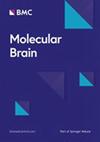TDP43 interacts with MLH1 and MSH6 proteins in a DNA damage-inducible manner
IF 3.3
3区 医学
Q2 NEUROSCIENCES
引用次数: 0
Abstract
Amyotrophic lateral sclerosis (ALS) is a fatal neurodegenerative disease that affects the motor neuron. One aspect of the neuropathology involved in ALS includes increased genomic damage and impaired DNA repair capability. The TAR-DNA binding protein 43 (TDP43) has been associated with both sporadic and familial forms of ALS, and is typically observed as cytosolic mislocalization of protein aggregates, termed TDP43 proteinopathy. TDP43 is a ubiquitous RNA/DNA binding protein with functional implications in a wide range of disease processes, including the repair of DNA double-strand breaks (DSBs). While TDP43 is widely known to regulate RNA metabolism, our lab has reported it also functions directly at the protein level to facilitate DNA repair. Here, we show that the TDP43 protein interacts with DNA mismatch repair (MMR) proteins MLH1 and MSH6 in a DNA damage-inducible manner. We utilized differentiated SH-SY5Y neuronal cultures to identify this inducible relationship using complementary approaches of proximity ligation assay (PLA) and co-immunoprecipitation (CoIP) assay. We observed that signals of TDP43 interaction with MLH1 and MSH6 increased significantly following a 2 h treatment of 10 μM methylmethanesulfonate (MMS), a DNA alkylating agent used to induce MMR repair. Likewise, we observed this effect was abolished in cell lines treated with siRNA directed against TDP43. Finally, we demonstrated these protein interactions were significantly increased in lumbar spinal cord samples of ALS-affected patients compared to age-matched controls. These results will inform our future studies to understand the mechanisms and consequences of this TDP43-MMR interaction in the context of ALS-affected neurons.TDP43 以 DNA 损伤诱导的方式与 MLH1 和 MSH6 蛋白相互作用
肌萎缩性脊髓侧索硬化症(ALS)是一种影响运动神经元的致命性神经退行性疾病。肌萎缩侧索硬化症的神经病理学特征之一是基因组损伤增加和 DNA 修复能力受损。TAR-DNA结合蛋白43(TDP43)与渐冻人症的散发性和家族性形式都有关联,通常表现为蛋白聚集的细胞膜错定位,称为TDP43蛋白病。TDP43 是一种无处不在的 RNA/DNA 结合蛋白,在多种疾病过程中具有功能性影响,包括 DNA 双链断裂(DSB)的修复。众所周知,TDP43 可调控 RNA 代谢,但我们实验室发现它还能直接在蛋白质水平上促进 DNA 修复。在这里,我们发现 TDP43 蛋白以 DNA 损伤诱导的方式与 DNA 错配修复(MMR)蛋白 MLH1 和 MSH6 相互作用。我们利用已分化的 SH-SY5Y 神经元培养物,通过近接试验(PLA)和共免疫沉淀(CoIP)试验这两种互补方法来确定这种诱导关系。我们观察到,在10 μM甲基甲磺酸甲酯(MMS)(一种用于诱导MMR修复的DNA烷化剂)处理2小时后,TDP43与MLH1和MSH6相互作用的信号显著增加。同样,我们还观察到,在使用针对 TDP43 的 siRNA 处理的细胞系中,这种效应也会消失。最后,我们证实,与年龄匹配的对照组相比,这些蛋白质相互作用在 ALS 患者的腰脊髓样本中明显增加。这些结果将有助于我们今后的研究,以了解在 ALS 受影响的神经元中 TDP43-MMR 相互作用的机制和后果。
本文章由计算机程序翻译,如有差异,请以英文原文为准。
求助全文
约1分钟内获得全文
求助全文
来源期刊

Molecular Brain
NEUROSCIENCES-
CiteScore
7.30
自引率
0.00%
发文量
97
审稿时长
>12 weeks
期刊介绍:
Molecular Brain is an open access, peer-reviewed journal that considers manuscripts on all aspects of studies on the nervous system at the molecular, cellular, and systems level providing a forum for scientists to communicate their findings.
Molecular brain research is a rapidly expanding research field in which integrative approaches at the genetic, molecular, cellular and synaptic levels yield key information about the physiological and pathological brain. These studies involve the use of a wide range of modern techniques in molecular biology, genomics, proteomics, imaging and electrophysiology.
 求助内容:
求助内容: 应助结果提醒方式:
应助结果提醒方式:


